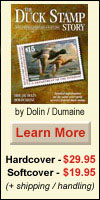 |
10% off on
web orders over $100 |
|
|

|
|
New federal error discovered!
For nearly 45 years an inverted back inscription on a United States federal duck stamp escaped discovery.
Now the newly discovered major error on the $2 Blue Geese stamp (RW22, issued July 1, 1955) joins nine other federal duck stamps with major errors.
These nine duck stamp errors are all listed in the accompanying chart.
Two other inverted back inscriptions have been discovered in the past five or so years: on RW24 (the $2 American eider stamp of 1957) and in 1998 on RW26 (the $3 Retriever with mallard stamp of 1959).
I know of only one example of RW26a and an estimated seven or eight of RW24a.
The new discovery on the 1955 stamp is known by only one example, as is the 1959 error. However, if collectors start turning over the stamps in their collections, other examples may surface.
While there is no way of determining how many 1955 errors exist, it is certain at least 112 were printed on the full sheet of four panes, 28 per pane. Perhaps the error was discovered immediately during production and corrected, or perhaps not.
It is possible that the other error stamps were mostly used by hunters. The back inscription, which appears on top of the gum, is lost when the stamp is moistened and affixed to the hunter's state license. Time will tell if more unused RW22 errors are out there.
Both the RW22 and RW26 errors have a common denominator in the intensity of the ink of the back inscription. Both are exceptionally dark, perhaps indicating that the stamps were among the first off the press.
The RW22 error originated in California, as did the RW26a. To the best of my knowledge, the RW24a inverted inscriptions were all found in Kansas.
An inverted inscription is easy to overlook. If printed correctly, the inscription reads properly when the stamp is turned as though it is a page in a book.
The error discovery has been sold to an advanced collector who wishes to remain anonymous. |
 Back | News Page
Back | News Page
|



















